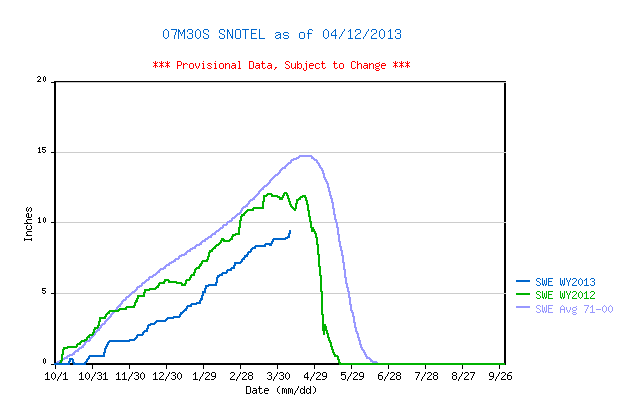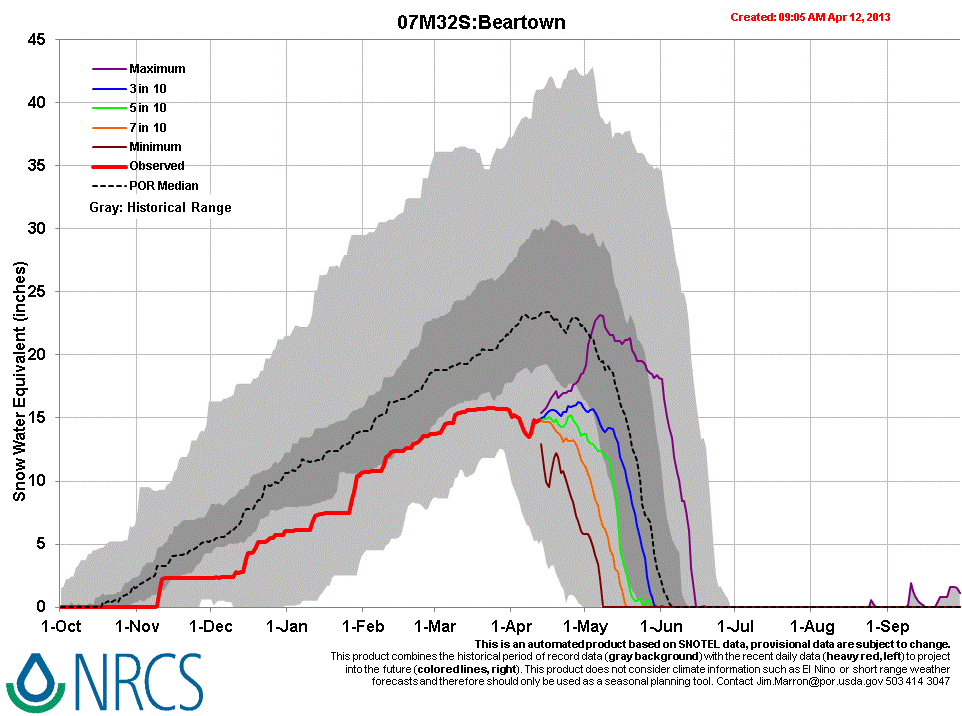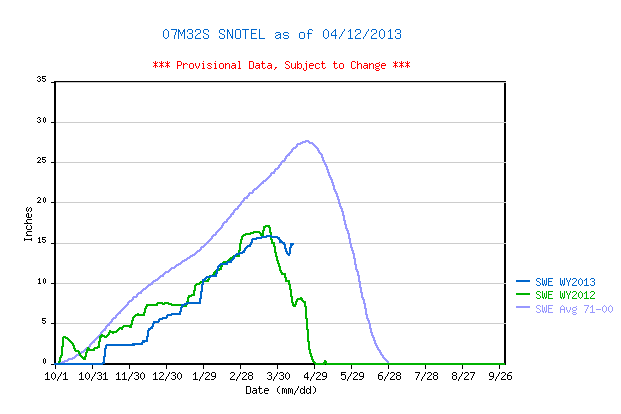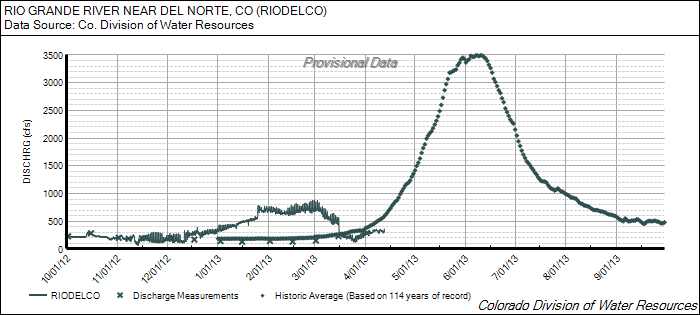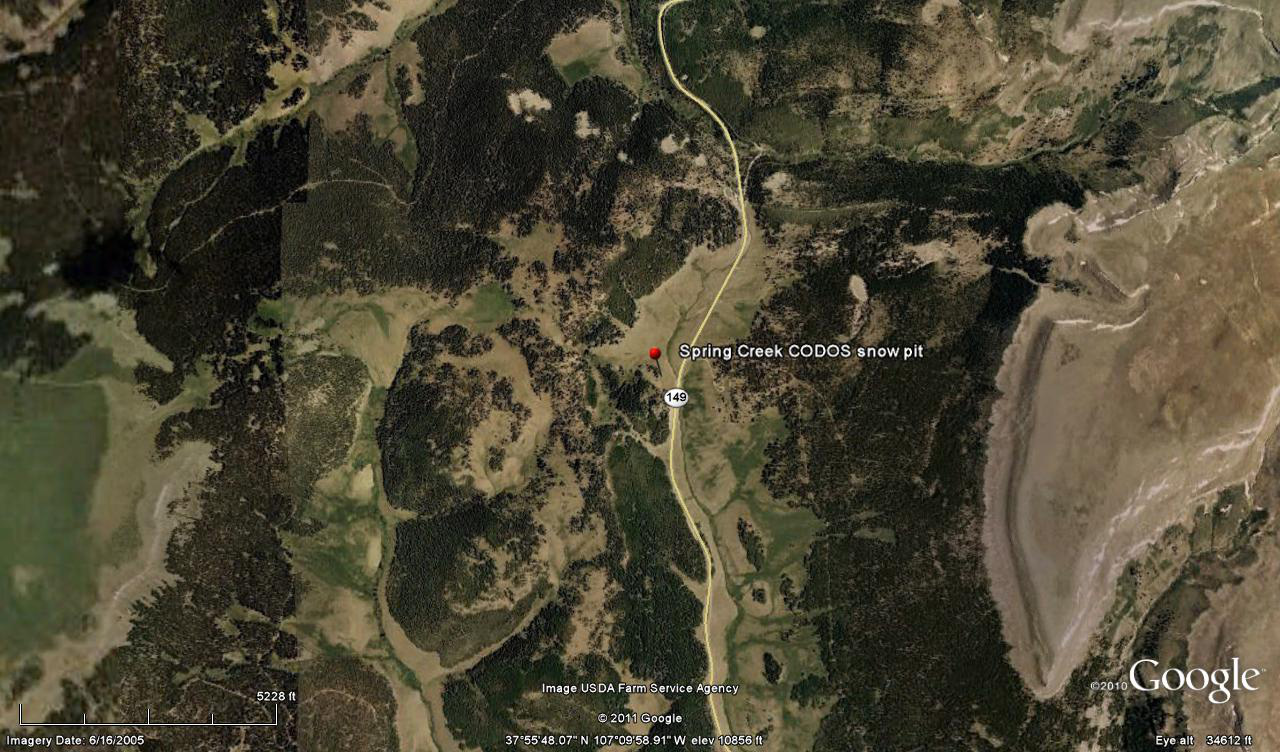 CODOS Update for Spring Creek Pass site:
CODOS Update for Spring Creek Pass site:
visited April 12, 2013
Summary | Snowpack | Melt Rate | Stream Flow | Forecast
Summary
Dust-in-snow layer D6 (April 8), likely merged with D5 (March 21-22), was found several inches below the snowpack surface at the Spring Creek Pass CODOS site on April 12, 2013, buried too deeply to substantially reduce snowcover albedo. The snowpack on the slightly NE-facing CODOS site continues to contain considerable cold content and will require additional warming before discharging snowmelt. Snowpack SWE at the CODOS site increased by 2.8” since our prior March 23, 2013 visit and was almost three times that observed a year earlier, on April 9, 2012. (Another winter storm immediately followed this site visit and yet another significant storm is predicted as of this writing, Monday, April 15.)
SnowPack Discussion
Total snow depth in the snow profile was almost 32”, 6” more than observed at the site on March 23, 2013. Total SWE on April 13, 2013 was also higher at 8.6”, up 2.8” of SWE since March 23, 2013. In contrast, this site was on the verge of “snow all gone” (SAG) by April 11, 2012, with only thin, scattered patches of snow on the ground.
Dust layer D6 (April 8) was seen as a distinct band within the snow that delivered that dust, and layer D5 (March 21-22) was likely contained in a melt/freeze crust just below, although it was not clearly evident during this visit. Clear evidence of D5 was observed in the area during the prior site visit. The basal layer in the snowpack was composed of still-dry chains of large depth hoar grains. Despite the clear evidence of a melt/freeze episode in the upper snowpack, snow temperatures were still cold and mean snowpack temperature was -3.0° C, substantially warmer than the -6.9° C mean on March 23, 2013 but still requiring significant warming to become isothermal and begin discharging snowmelt runoff.
By interpolation, from Senator Beck Basin to Spring Creek Pass, we are confident that the upper Rio Grande watershed snowcover contains very substantial D6 dust. Further, we assume that southerly aspects have isothermal snowcover, where any snowcover remains.
April 12, 2013 Slumgullion Snotel data reports current SWE near the bottom of the lower quartile of SWE values for the period of record, but still rising. Farther west, in the Rio Grande headwaters, the Beartown Snotel may have recorded Peak SWE and have begun its general decline, with occasional upticks from spring snowfall. This season’s SWE at Slumgullion has yet to match the Peak SWE of spring 2012, and remains well below the 1971-2000 mean. Beartown has come closer to WY 2012 peak SWE, but also remains well below average.
| March 23rd Pit Profile | April 12th Pit Profile | |
 |
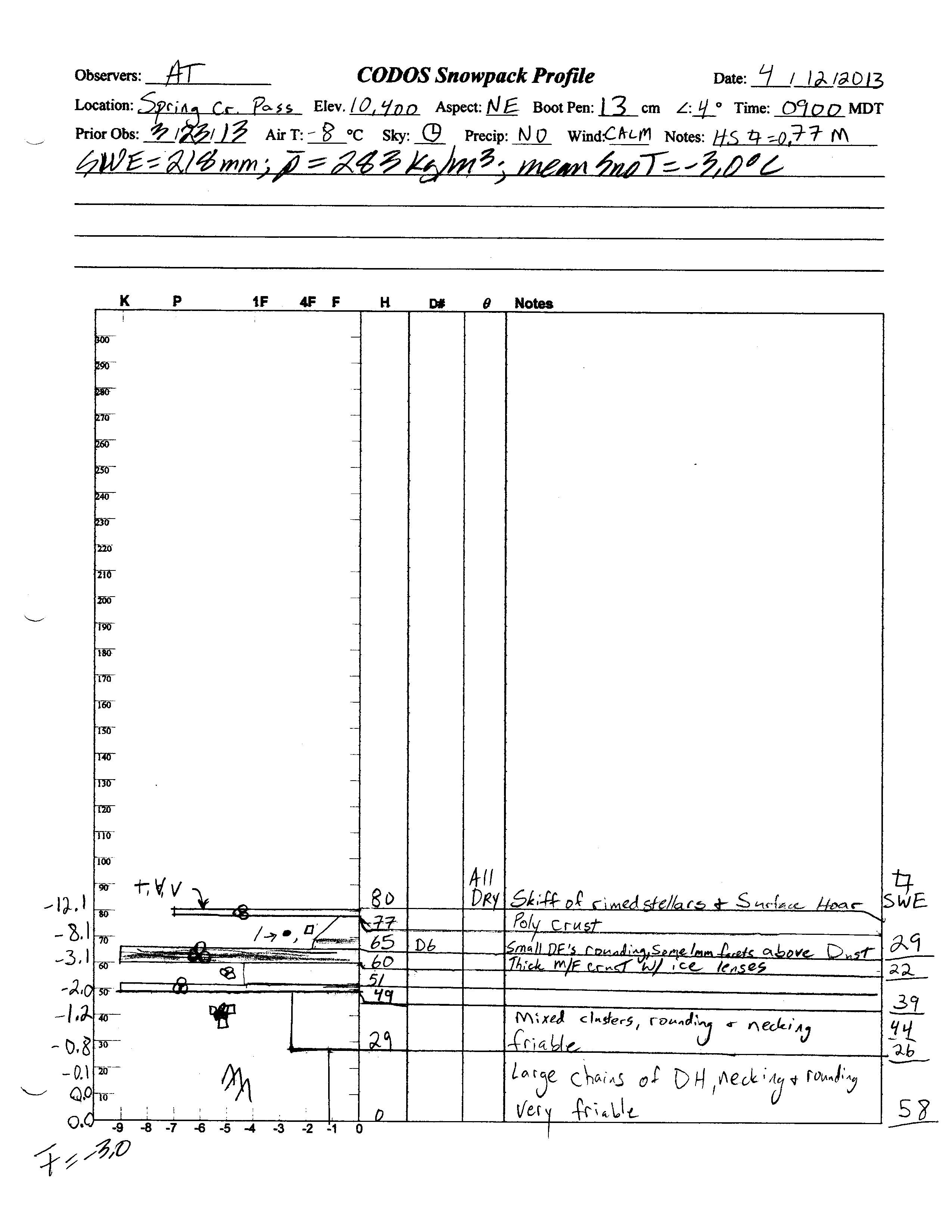 |
Melt Rate
The comparatively shady Slumgullion Snotel site has not reported data since April 9 but had reported slowly increasing or ‘flat’ SWE values since mid-March, with no significant declines in SWE. The Spring Creek Pass CODOS site has also gained SWE and the snowpack there remains ‘cold’ (not yet isothermal) and is conserving that SWE for the time being. However, even nearby and to a greater extent just a few miles down valley, snowcover is rapidly decreasing or gone, and D6 was nearer to or at the surface, as of April 12. Since the site visit, the Spring Creek Pass locale has received modest amounts of fresh snow that will somewhat reduce the near-term impact of dust layers D6/D5 on snow albedo. As and when merged layers D6/D5 do more-or-less fully emerge, and remain exposed for some days, snowmelt rates will accelerate rapidly in the Rio Grande River watershed and could result in SWE loss rates matching the 1.3” losses per day (maximum 5-day moving average) observed in spring 2012, even absent additional dust this spring. Ablation of this season’s sub-par Spring Creek Pass snowcover to “snow all gone” (SAG) will also be significantly advanced by merged layers D6/D5, as and when those (and/or additional dust layers) remain exposed for sustained periods.
Stream Flow
Streamflow data from the Rio Grande at Del Norte gauge do not yet present clear evidence of dust-enhanced snowmelt runoff, to-date, whether from event D5 or D6. (A new dust event verified at Senator Beck Basin on April 14, event D7, is certain to have also been deposited in the Rio Grande watershed). However, we are confident that flows will surge substantially as and when dust layers D5/D6, and eventually perhaps D2, emerge and remain at the surface for extended periods. Snowmelt runoff duration may then be substantially shortened as the sub-par snowcover is consumed at an increased rate and cannot sustain what may be only briefly higher flows.
Forecast
As of Monday, April 15, the National Weather Service expects unsettled weather to continue through most of the week of April 14-20. A significant weather system is expected to arrive today (Monday, April 15) with strong S and SW’ly winds. (We have reports of yet another dust storm in progress in Durango, likely dust-on-snow event D8). A Winter Storm Watch has been issued for up to 12” of new snow, or more, at Slumgullion Pass. Somewhat lesser amounts will fall in the upper Rio Grande watershed. Partly sunny weather may return to the San Juan Mountains by Thursday, but no prolonged drying is anticipated at this time as the weather remains “progressive”, with an another potential system shaping up for next Saturday, primarily affecting the northern mountains.
Given additional new snowfall during the week of April 14-20, and without further dust-on-snow, the emergence of dust layers D6/D5 (and D2 where present) will be aspect and elevation driven, with earliest exposure at lowest snow-covered elevations, perhaps quickly followed at Pass elevations. Wind stripping may also reveal patches of dust-in-snow in exposed, alpine locations. Even on mostly cloudy days, sufficient radiation may reach the snowpack to penetrate new snow and reaching the D6/D5 layer below and accelerate the ablation of the new snow received this week.


